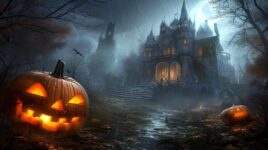
Do They Celebrate Halloween in Spain
Do they celebrate Halloween in Spain? The cultural celebration of Halloween in Spain is a topic that has garnered much interest and curiosity. In this article, we will delve into the origins, traditions, and controversies surrounding the observance of Halloween in this fascinating European country.
Spain has a rich and diverse cultural heritage, and its approach to Halloween reflects this diversity. From the historical roots of the holiday to the modern-day festivities, there is much to explore about how Spaniards embrace this popular celebration.
The history of Halloween in Spain is a story that intertwines with religious observances, traditional customs, and contemporary influences. As we trace the evolution of this holiday in the country, we gain insight into how it has become an integral part of Spanish culture.
In addition to exploring the history of Halloween in Spain, we will also delve into the various traditions and customs associated with the holiday. From regional variations in celebrations to the culinary delights enjoyed during this time, there is much to uncover about how Spaniards mark this occasion.
Furthermore, we will examine Dia de Todos los Santos, which is the Spanish equivalent of All Saints’ Day, and its connection to Halloween. This religious observance provides valuable context for understanding how Halloween is intertwined with traditional Catholic practices in Spain.
As we venture through this exploration of Halloween in Spain, we will also address the impact of commercialization on the holiday. American influences and consumerism have undoubtedly played a role in shaping how Halloween is celebrated in Spain, leading to debates and objections within Spanish culture.
History of Halloween in Spain
The roots of Halloween in Spain can be traced back to the ancient Celtic festival of Samhain, which marked the end of the harvest season and the beginning of winter. This festival was also thought to be a time when the boundaries between the living and the dead were blurred, allowing spirits to roam the earth.
When Christianity spread to Celtic lands, Samhain merged with All Saints’ Day, which is celebrated on November 1st, and All Souls’ Day, observed on November 2nd. These Christian holidays brought their own traditions and practices that influenced how Halloween is celebrated in Spain today.
Spanish Influence on Halloween
Over time, Spanish culture has left its mark on the way Halloween is observed in the country. The Spanish tradition of honoring deceased loved ones on Dia de Todos los Santos (All Saints’ Day) has intertwined with Halloween festivities.
In some regions of Spain, families visit cemeteries to clean and decorate graves, bring flowers, and light candles in remembrance of their departed relatives. This blend of customs reflects both the historical and religious influences on how Halloween is perceived in Spain.
Modern Adaptations
In contemporary Spain, particularly in urban areas, many people have embraced Halloween as an opportunity for costume parties, trick-or-treating, and themed events at schools and businesses. However, the commercialization of Halloween has fueled debates about its authenticity as a cultural celebration and its impact on local traditions. Some Spaniards argue that Halloween has been overly influenced by commercial interests from abroad, diluting its connection to Spanish heritage.
Regional Variations
It’s worth noting that there are regional variations in how Halloween is celebrated throughout Spain. In Catalonia, for example, there’s a long-standing tradition called La Castanyada where people eat chestnuts and sweet potatoes while telling stories about deceased relatives. Meanwhile, in Galicia, there’s a similar festival called Noite dos Calacús (Night of Pumpkins) that involves carving pumpkins into jack-o’-lanterns just like in American Halloween traditions but with a local twist.
As we delve deeper into understanding the history of Halloween in Spain, it becomes clear that this holiday has evolved over centuries due to a combination of ancient Celtic influences, Christian practices, regional customs, and global trends. The next section will explore these different aspects further by examining how Halloween is celebrated across various regions within Spain.
Traditions and Customs
In Spain, Halloween, or “Noche de Brujas” as it is often referred to, is celebrated with a unique blend of traditional customs and modern festivities. The observance of Halloween varies from region to region, with each area incorporating its own cultural practices into the holiday. Let’s explore how Halloween is celebrated in different parts of Spain:
1. Catalonia: In Catalonia, the celebration of Halloween is intertwined with the observance of “La Castanyada,” a traditional festival that pays homage to the deceased. During this time, people gather to eat roasted chestnuts and sweet potatoes, and often visit cemeteries to honor their loved ones. Additionally, children go trick-or-treating and participate in costume parades, blending elements of both Halloween and La Castanyada.
2. Galicia: In the northwest region of Galicia, Halloween is observed alongside “Samaín,” a Gaelic festival that marks the end of the harvest season. Families come together to share meals featuring local delicacies such as filloas (thin pancakes) and roasted chestnuts. Bonfires are also lit to ward off evil spirits and protect the community.
3. Basque Country: In the Basque Country, Halloween celebrations are combined with “Gaztain Jai,” a festival dedicated to chestnuts. People indulge in dishes made with chestnuts while participating in street fairs and costumed events. Like other regions in Spain, children also engage in trick-or-treating activities.
4. Andalusia: In southern Spain, particularly in Andalusia, Halloween has become increasingly popular among younger generations. Many towns host themed parties and costume contests, while some communities organize scary movie marathons and haunted house experiences.
5. Canary Islands: On the tropical islands of the Canary Islands archipelago, Halloween takes on a vibrant and festive atmosphere characterized by elaborate decorations and lively street celebrations. Tourists and locals alike partake in costume parades, outdoor concerts, and spooky-themed food tastings.
As we can see, the celebration of Halloween across different regions of Spain demonstrates a rich tapestry of cultural diversity and historical influences that contribute to its unique customs and traditions.
Dia De Todos Los Santos
Religious Significance
Dia de Todos los Santos, which falls on November 1st, is a day dedicated to honoring all the saints, known and unknown, in the Catholic Church. It is a time for families to visit cemeteries and pay respects to their deceased loved ones by adorning graves with flowers and lighting candles. The religious observance of Dia de Todos los Santos reflects Spain’s deep-rooted Catholic heritage and plays a significant role in shaping the country’s cultural practices.
Connection to Halloween
In Spain, Dia de Todos los Santos is intricately connected to Halloween, with both holidays sharing certain customs and themes. While Halloween has become more commercialized in recent years, many Spaniards still observe Dia de Todos los Santos as a solemn occasion marked by visits to cemeteries and special church services. The emphasis on remembering the departed during this time echoes the themes of remembrance and honoring ancestors commonly associated with Halloween.
Cultural Traditions
On Dia de Todos los Santos, it is customary for families to gather for elaborate meals featuring traditional dishes such as buñuelos (fried dough pastries) and huesos de santo (marzipan confections). This culinary aspect of the holiday adds another layer of cultural richness to Dia de Todos los Santos as families come together to share food and memories while honoring their departed relatives.
Symbolism
The imagery associated with Dia de Todos los Santos often includes marigolds, which are believed to guide spirits back to the living world. This tradition bears similarities to Día de Muertos or Day of the Dead celebrations in other Spanish-speaking countries, further illustrating how different cultural influences have shaped Spain’s observance of this time-honored holiday.
Integration With Modern Customs
As Spain continues to embrace global influences, there has been an infusion of elements from Halloween into Dia de Todos los Santos celebrations. It is not uncommon for children to dress up in costumes reminiscent of those seen during Halloween festivities in other parts of the world. This blending of traditions showcases how cultural exchange has influenced the way Spaniards recognize these interconnected holidays.
In understanding Dia de Todos los Santos and its connection to Halloween, one gains insight into the rich tapestry of Spanish culture that intertwines religious observances with modern customs. The significance of honoing saints while also acknowledging departed loved ones mirrors the universal themes found in festivals around the world.
Commercialization of Halloween
The celebration of Halloween in Spain has undoubtedly been influenced by American culture and consumerism. While the holiday has a long-standing history in Spanish culture, the modern commercialization of Halloween can be attributed to the influence of American traditions and marketing.
In recent years, the commercialization of Halloween in Spain has become increasingly prominent. This can be seen in the widespread availability of Halloween costumes, decorations, and themed merchandise in stores across the country. Additionally, the influence of American media and pop culture has contributed to the popularization of Halloween parties, events, and activities in Spain.
One notable impact of American influences on Halloween in Spain is the widespread adoption of trick-or-treating among children. While this tradition was not traditionally part of Spanish Halloween celebrations, it has become increasingly common in urban areas and residential neighborhoods. The popularity of trick-or-treating reflects the influence of American customs on the way Halloween is celebrated in Spain.
The commercialization of Halloween has also led to an increase in themed events and attractions throughout Spain. From haunted houses to costume parties, businesses and organizations have capitalized on the holiday by offering a variety of entertainment options for both locals and tourists. This commercialization has transformed Halloween from a relatively low-key observance to a more mainstream cultural phenomenon.
However, with these changes also comes criticism and concerns about cultural appropriation and consumerism. Some Spaniards have voiced objections to what they perceive as the “Americanization” of their traditional holidays, including Dia de Todos los Santos (All Saints’ Day), which coincides with Halloween. There are debates about whether embracing American traditions detracts from or dilutes Spanish cultural identity.
| Impact | Description |
|---|---|
| Trick-or-treating | The widespread adoption reflects American influences. |
| Themed events | Businesses offer a variety of entertainment options for locals and tourists. |
| Objections | Debates about cultural appropriation and “Americanization”. |
Controversy and Criticism
Halloween has become a popular and widely celebrated holiday in many parts of the world, but in Spain, its adoption has not been without controversy and criticism. As the country has grappled with embracing this American tradition, there have been debates and objections surrounding its impact on Spanish culture.
One of the main points of contention regarding Halloween in Spain is its perceived commercialization. Many critics argue that the holiday has been overly influenced by consumerism, leading to a focus on costumes, decorations, and confectionery sales. This trend is seen as detracting from the traditional and religious observance of Dia de Todos los Santos (All Saints’ Day) and Dia de los Muertos (Day of the Dead), which are deeply rooted in Spanish culture.
Moreover, there are concerns about the potential dilution or distortion of indigenous Spanish traditions as a result of the growing prominence of Halloween. Some fear that the adoption of this foreign holiday may overshadow or replace local customs and festivities that hold historical and cultural significance for Spaniards.
In addition to cultural critiques, there have also been religious objections to Halloween in Spain. Some members of the Catholic Church have voiced disapproval of the holiday, citing its pagan roots and associations with death and darkness. They argue that Halloween’s themes contradict the spiritual values upheld during All Saints’ Day and All Souls’ Day observances.
Furthermore, social commentators have raised questions about the impact of Halloween on children in Spain. Concerns about excessive consumption of sweets, exposure to frightening imagery, and pressure to participate in costly costume parties have sparked discussions about whether these aspects align with Spanish values and educational priorities.
As Spain continues to navigate these controversies surrounding Halloween, it remains an ongoing topic of debate within the country. Despite differing opinions, it is evident that discussions around traditional versus modern customs will continue to shape how Spaniards perceive and celebrate Halloween in their culture.
Halloween Events and Festivities
In recent years, the celebration of Halloween in Spain has become increasingly popular, with a growing number of parties, parades, and haunted attractions held throughout the country. While Halloween is not a traditional Spanish holiday, its adoption has led to a surge in festive events that cater to both locals and tourists.
One notable event is the annual Halloween parade in Madrid, which draws thousands of people dressed in elaborate costumes, marching through the streets of the city. This lively procession is accompanied by music, dancing, and various performances, creating a vibrant and spirited atmosphere for all participants.
Similarly, Barcelona also hosts its own Halloween festivities, including themed parties at nightclubs and bars, as well as spooky walking tours that explore the city’s haunted history. Visitors can enjoy special Halloween menus at restaurants and indulge in themed cocktails at trendy establishments throughout the city.
For those seeking a more adrenaline-pumping experience, Spain offers a variety of haunted attractions during the Halloween season. From interactive horror experiences to haunted houses and mazes, thrill-seekers can immerse themselves in spine-tingling adventures that are sure to get their hearts racing.
In addition to organized events in major cities such as Madrid and Barcelona, smaller towns and rural areas across Spain also embrace the spirit of Halloween with their own unique celebrations. From community festivals to costume contests and pumpkin carving competitions, there is no shortage of merriment to be found throughout the country during this time of year.
Overall, the widespread availability of Halloween events and festivities across Spain reflects the increasing popularity and integration of this cultural celebration into Spanish society. Whether it’s through elaborate parades, themed parties, or immersive experiences, there are plenty of opportunities for locals and visitors alike to join in on the spooky fun.
| Halloween Event | Location |
|---|---|
| Annual Halloween Parade | Madrid |
| Themed Parties & Walking Tours | Barcelona |
| Haunted Houses & Mazes | Various Locations |
| Community Festivals & Contests | Rural Areas |
Culinary Delights
Halloween in Spain is not just about dressing up and parties, but it also involves indulging in delicious traditional foods and treats. In this section, we will explore the culinary delights that are enjoyed during the Halloween season in Spain.
One of the most popular traditional Halloween foods in Spain is the “Huesos de Santo” or “Bones of the Holy.” These delicious marzipan sweets are shaped like bones and filled with sweet fillings such as custard or chocolate. They are often enjoyed during All Saints’ Day, which falls on November 1st, and are a delightful treat that is eagerly anticipated by both children and adults.
Another traditional Halloween treat in Spain is “Panellets,” which are small cakes made from ground almonds, sugar, and eggs. These tasty confections are typically coated in pine nuts or almonds and are a staple during All Saints’ Day celebrations. Panellets come in various flavors such as lemon, chocolate, and coconut, making them a versatile and beloved Halloween delicacy.
In addition to sweet treats, savory dishes also play a significant role in Halloween celebrations in Spain. One popular dish is “Calabaza Rellena,” which translates to stuffed pumpkin. This hearty dish consists of a whole pumpkin filled with a flavorful mixture of rice, vegetables, sausage, and spices. It is then baked until the pumpkin flesh is tender, creating a delicious and festive meal that is perfect for sharing with loved ones during Halloween gatherings.
Furthermore, “Buñuelos de Viento” or “Wind Fritters” are another favorite Halloween treat in Spain. These light and airy fritters are made from choux pastry dough that is deep-fried until golden brown. They can be dusted with powdered sugar or drizzled with honey for an extra touch of sweetness. Buñuelos de Viento are often enjoyed during All Saints’ Day festivities as a delightful accompaniment to hot chocolate or coffee.
As you can see, the culinary traditions surrounding Halloween in Spain offer an array of delectable treats that add to the festive atmosphere of this cultural celebration. From sweet marzipan bones to savory stuffed pumpkins, these traditional foods play an essential role in bringing friends and family together to celebrate this special time of year.
So next time you ask yourself “Do they celebrate Halloween in Spain?” remember that not only do they embrace this holiday but they also have their own unique culinary traditions that make it truly special.
Importance of Religion
Halloween is celebrated with great enthusiasm all over the world, but the question remains: do they celebrate Halloween in Spain? The answer is yes, though it may not be as widely observed as it is in the United States or other countries. Despite this, Halloween has made its mark on Spanish culture, and there are various ways in which it is celebrated, influenced by both religious and commercial factors.
In Spanish culture, religion plays a significant role in shaping traditions and celebrations. This is evident in the observance of All Saints’ Day, known as Dia de Todos los Santos in Spain, which falls on November 1st.
This holiday has deep religious roots and serves as a day to honor and remember the saints and departed loved ones. While Halloween itself may have more secular origins, its proximity to All Saints’ Day has led to some intertwining of customs and observances.
One such example of this intertwining can be seen in the tradition of visiting cemeteries during Dia de Todos los Santos. Families come together to clean and decorate the graves of their deceased relatives with flowers and candles. This act of remembrance and reverence for the departed aligns with the spiritual aspects of Halloween, particularly its focus on spirits and the afterlife.
While it is true that Halloween has become increasingly commercialized in Spain, with costume parties and themed events becoming more prevalent, there are still many who prioritize the religious aspect of Dia de Todos los Santos. For these individuals, Halloween may hold less significance or be integrated into their observance of All Saints’ Day. Nevertheless, both holidays provide opportunities for reflection on mortality and spiritual beliefs.
In recent years, there has been some controversy surrounding the adoption of Halloween in Spanish culture, particularly among those who view it as a foreign import that detracts from traditional customs. However, for many people in Spain – especially younger generations – celebrating Halloween is simply a fun way to enjoy time with friends and family while embracing spooky themes and dressing up in costumes.
Overall, while the religious significance of Halloween may vary among individuals in Spanish society, there is no denying that it holds a place within the country’s cultural landscape. Whether through traditional observances or modern festivities, Halloween continues to be an occasion where people come together to honor their beliefs and celebrate life.
Conclusion
In conclusion, the celebration of Halloween in Spain is a fascinating blend of tradition, history, and contemporary influences. While the holiday has gained popularity in recent years, it is essential to recognize the deep-rooted customs and beliefs that shape its observance in Spanish culture. The history of Halloween in Spain demonstrates a rich tapestry of influences, from ancient Celtic rituals to Christian traditions, ultimately evolving into a unique and vibrant celebration.
The diverse regional variations in how Halloween is celebrated across Spain add depth and complexity to the holiday’s significance. From parades to haunted attractions, communities across the country come together to mark this occasion with enthusiasm and creativity. It is evident that while Halloween may have American influences, its observance in Spain speaks to the country’s unique cultural identity.
One cannot discuss Halloween in Spain without acknowledging Dia de Todos los Santos, the Spanish equivalent of All Saints’ Day. This traditional religious observance intertwines with Halloween, offering a nuanced perspective on how Spain honors its departed loved ones during this time of year. The culinary delights associated with Halloween in Spain also reflect a blend of old-world flavors and modern twists, showcasing the country’s rich gastronomic heritage.
Despite the commercialization and controversy surrounding Halloween’s adoption in Spanish culture, one cannot deny the palpable energy and excitement that surrounds this holiday. From lively events to delicious delicacies, it is clear that Halloween has found its place within the fabric of Spanish society. Whether one chooses to embrace or critique its presence, there is no denying that Halloween has become an integral part of Spain’s cultural landscape.



